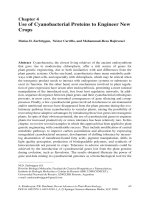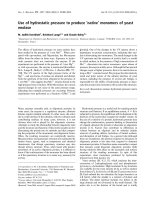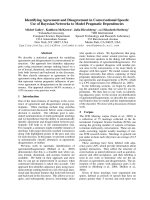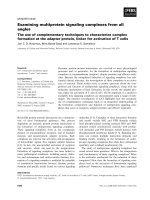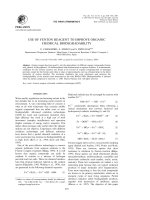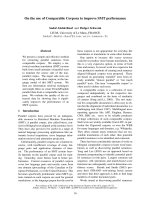Use of fetotomy technique to resolve dystocia due to wry neck ankylosed fetus in a mare
Bạn đang xem bản rút gọn của tài liệu. Xem và tải ngay bản đầy đủ của tài liệu tại đây (204.22 KB, 4 trang )
Int.J.Curr.Microbiol.App.Sci (2019) 8(4): 2464-2467
International Journal of Current Microbiology and Applied Sciences
ISSN: 2319-7706 Volume 8 Number 04 (2019)
Journal homepage:
Case Study
/>
Use of Fetotomy Technique to Resolve Dystocia due to Wry Neck
Ankylosed Fetus in a Mare
Navdeep Singh1*, Sarvpreet SinghGhuman2, Navgeet Singh3,
Navjot Singh3 and Randhir Singh3
1
Veterinary Gynaecologist, Directorate of Livestock Farm, 2Department of Teaching
Veterinary Clinical Complex, 3Department of Veterinary Gynaecology and Obstetrics,
Guru Angad Dev Veterinary and Animal Sciences University, Ludhiana - 141 004, India
*Corresponding author
ABSTRACT
Keywords
Ankylosis,
Dystocia, Fetotomy,
Wry neck, Mare
Article Info
Accepted:
17 March 2019
Available Online:
10 April 2019
The current communication reports a case of dystocia due to wry neck and
ankylosed limbs in a mare. The dead fetus was delivered successfully by
giving a single cut on the neck using the fetotomy technique.
Introduction
Period of foaling is considered as a critical
event for equine breeders. Any abnormality
during foaling is one of the most challenging
conditions faced by equine practitioners. The
incidence of dystocia is reported to be 4% in
thoroughbred mares and malposture of long
fetal extremities, head, and neck are the major
cause of dystocia in mare (Thangamani et al.,
2018). Furthermore, the time taken during
obstetrical maneuvering is very crucial for the
survivability of fetus and mare as well as the
subsequent fertility of the mare (Frazer,
2007). One or two well-placed fetotomy cuts
can dramatically shorten the intervention time
(Nimmo et al., 2007). The present report
describes a rare case of dystocia in a mare due
to wry neck ankylosed fetus and its successful
management through partial fetotomy
operation.
Case history and observations
A six years old full-term pregnant mare in her
second parity was presented to the University
Veterinary Hospital with the history of severe
straining for the last 6-8 hours. Visibly, both
ankylosed forelimbs with knee flexion were
hanging out from the vulva (Fig. 1). General
2464
Int.J.Curr.Microbiol.App.Sci (2019) 8(4): 2464-2467
clinical examination revealed that the mare
was alert with 102.4ºF body temperature.
Mare’s tail was wrapped and the perineal
region was thoroughly cleansed with an
antiseptic solution.
Following epidural anesthesia with 5 ml of
2% Lignocaine hydrochloride solution at first
inter-coccygeal space, a thorough vaginal
examination was performed which revealed a
fully dilated cervix with moist birth canal.
The fetus, without any reflex, was in anterior
longitudinal presentation with severe lateral
deviation of the head. The neck seemed to be
stiff (wry neck). Taking all these findings into
consideration, it was decided to relieve
dystocia through fetotomy.
Treatment
Following epidural anesthesia and ample
lubrication with 1% solution of sodium salt of
carboxymethyl cellulose gel, partially loaded
fetotome was introduced in the uterus and
wire was placed around neck with the help of
calving rope carrier. Head of the fetotome
was placed at the base of the neck between
both forelimbs (Fig. 2). After amputating the
fetal head at the level of the neck, it was
removed by applying traction. The head
amputation proved miraculous which resulted
in the delivery of rest of the fetus by applying
traction on forelimbs after lubrication. The
mare was discharged with the routine
prescription of antibiotics and supportive
therapy and referred to the general
veterinarian for medical follow-up.
Fig.1 Mare at case presentation; both ankylosed forelimbs hanging out from vulva
2465
Int.J.Curr.Microbiol.App.Sci (2019) 8(4): 2464-2467
Figure.2 Foal with wry neck and ankylosed limbs; placement of fetotome
The incidence of dystocia in mare has been
much less documented than bovines (Frazer,
2007). Fetal monsters are rare in horses.
However, hydrocephalus (Dugdale, 2007),
Schistosomar eflexus, ankylosis of one or
more limbs and wry neck are known to occur
(Ball 2005). Maldisposed dead fetuses can be
safely resolved for vaginal delivery through
fetotomy performed by skilled persons,
otherwise, it is potentially hazardous for the
mare (Higgins and Wright, 1999). One to two
well-placed fetotomy cuts can dramatically
shorten the intervention time and permit a
traumatic delivery of a nonviable fetus
(Nimmo et al., 2007). The value of mare is an
important factor to be considered. In one
study, one or two cuts were sufficient to
correct 57% of the cases, and another 21%
required a third cut (Frazer, 1997). The
survival rate of mares subsequent to fetotomy
was 95.8% in one study (Carluccio et al.,
2007) and 100 percent in another (Volkmann,
2009). The short term and long term fertility
of mares appears to be good with 80 to 83%
mares conceiving subsequently (Carluccio et
al., 2007; Nimmo et al., 2007).
Summary
In the present case, dystocia in a mare due to
fetal abnormalities viz. ankylosis of forelimbs
and wry neck was observed. A single cut on
the neck to amputate and remove head proved
helpful in the delivery of malpostured fetus. It
is thus concluded that fetotomyis a potential
tool to relieve dystocia due to wry neck and
ankylosed fetal limbs in mares. Furthermore,
fetotomy is a relatively non-invasive and
economical way to handle these obstetrical
emergencies when compared to the cesarean
section. Also, recovery is uneventful without
much intensive care and complications which
may otherwise be encountered after the
cesarean section.
References
Ball, B.A. 2005. Dystocia in the mare:
Management and decision making.
Proc. Annu. Meet Italian Assoc. Equine
Vet pisa. p1-4 Italy.
Carluccio, A., Contri, A., Tosi, U., De
Amicis, I., De Fantic. 2007. Survival
rate and short term fertility rate
2466
Int.J.Curr.Microbiol.App.Sci (2019) 8(4): 2464-2467
associated with the use of fetotomy for
resolution of dystocia in mare: 72 cases
(1991-2005). J. Am. Vet. Med. Assoc.
230: 1502-1505.
Dugdale, D.J. 2007. Dystocia- BEWA Equine
Stud Medicine Course p 225-28.
Frazer, G.S.2007. Dystocia and Fetotomy. In:
Samper JC, Pycock JF, Mc Kinnon AO
eds Current Therapy in Equine
Reproduction.
Saunders
Elsevier.
Missourri. Pp. 417-34.
Frazer, G.S., Perkins, N.R., Blanchard, T.L.,
Lock, T.F., Sertich, P.L., Baker, G.J.,
Vaala, W.E. 1997. Prevalence of fetal
maldispositions in equine referral
hospital dystocias. Equine. Vet. J. 29:
111-116
Higgins, A.J., Wright, I.M. 1999. The Equine
Manual, Saunders, Oval Road, London.
Nimmo, M.R., Slone, D.E., Hughes, F.E.,
Linch, T.M, Clark, C.K. 2007. Fertility
and Complications after fetotomy in
twenty brood mares (2001-2006). Vet.
Surg. 36: 771-774.
Stephenson, R. 2010. Correction of dystocia
in a mare by fetotomy. UK. Vet. 15: 913.
Thangamani,
A.,
Srinivas,
M.,
Chandraprasad, B., and Phanikumar, L.
2018. Periparturient event and dystocia
in equine- A review. Int. J. Sci. Environ.
Tech. 7(2): 648–658.
Volkmann, D. 2009. Practical management of
equine dystocia. Proc. Scientific. Assoc.
for health (WVGP) Merelbeke. Pp. 111.
How to cite this article:
Navdeep Singh, Sarvpreet Singh Ghuman, Navgeet Singh, Navjot Singh and Randhir Singh.
2019. Use of Fetotomy Technique to Resolve Dystocia due to Wry Neck Ankylosed Fetus in a
Mare. Int.J.Curr.Microbiol.App.Sci. 8(04): 2464-2467.
doi: />
2467

